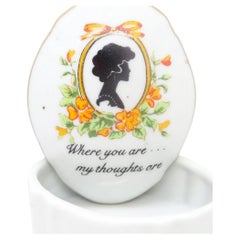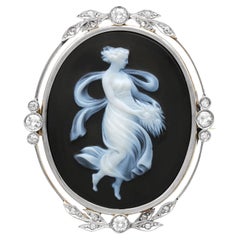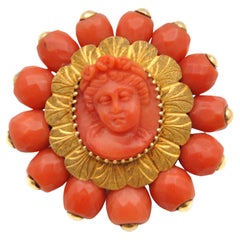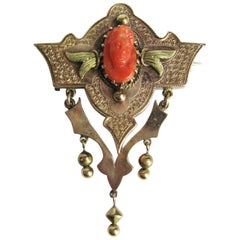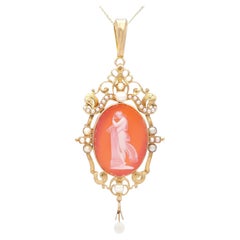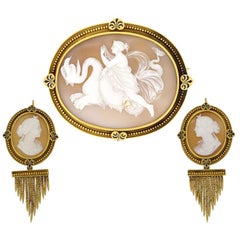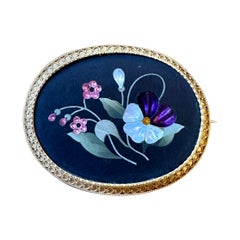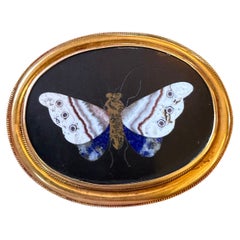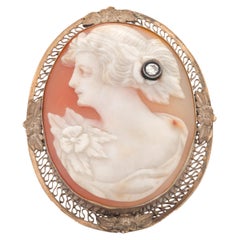Antique Cameo Jewelry
1880s English Antique Cameo Jewelry
1880s Unknown Antique Cameo Jewelry
Diamond, Yellow Gold, Silver
Late 19th Century European Victorian Antique Cameo Jewelry
Coral, Gold, 14k Gold
1870s Unknown Victorian Antique Cameo Jewelry
Coral, 14k Gold, Yellow Gold, Gold
1880s Unknown Antique Cameo Jewelry
Pearl, Quartz, Yellow Gold
1870s English Victorian Antique Cameo Jewelry
Yellow Gold
19th Century Italian Etruscan Revival Antique Cameo Jewelry
Multi-gemstone, Onyx, Amethyst, Gold, 14k Gold, Yellow Gold
19th Century Italian Victorian Antique Cameo Jewelry
Multi-gemstone, Onyx, Agate, Lapis Lazuli, Gold, 14k Gold, Yellow Gold
Early 20th Century American Art Deco Antique Cameo Jewelry
Diamond, Gold, 14k Gold, White Gold
19th Century Italian Etruscan Revival Antique Cameo Jewelry
Onyx, Gold, 14k Gold, Yellow Gold
Mid-19th Century Italian Art Deco Antique Cameo Jewelry
Early 20th Century Antique Cameo Jewelry
Coral, 14k Gold, Yellow Gold
Early 20th Century Late Victorian Antique Cameo Jewelry
Gold, 18k Gold, Yellow Gold
Early 20th Century Art Deco Antique Cameo Jewelry
14k Gold, Gold, Yellow Gold
Late 19th Century Unknown Antique Cameo Jewelry
Carnelian, 14k Gold, Yellow Gold
19th Century French Victorian Antique Cameo Jewelry
Agate, Diamond, 18k Gold
Early 20th Century American Art Deco Antique Cameo Jewelry
Gold, 14k Gold, White Gold
Early 20th Century American Art Deco Antique Cameo Jewelry
Tiger's Eye, Yellow Gold, White Gold, 10k Gold, Gold
19th Century Unknown Victorian Antique Cameo Jewelry
Diamond, Pearl, 18k Gold, Yellow Gold
Early 1900s Unknown Victorian Antique Cameo Jewelry
Pearl, 14k Gold, Yellow Gold
Late 19th Century European Victorian Antique Cameo Jewelry
Gold, Silver
1880s American Victorian Antique Cameo Jewelry
14k Gold
17th Century Italian Renaissance Antique Cameo Jewelry
Multi-gemstone, Pearl, 18k Gold, Enamel
Late 19th Century Italian Victorian Antique Cameo Jewelry
14k Gold
19th Century Antique Cameo Jewelry
18k Gold
19th Century Neoclassical Antique Cameo Jewelry
Yellow Gold
Mid-19th Century English Victorian Antique Cameo Jewelry
9k Gold
1850s French Napoleon III Antique Cameo Jewelry
1870s French Artisan Antique Cameo Jewelry
Pearl, Chalcedony, 18k Gold, Gold
19th Century British Victorian Antique Cameo Jewelry
Early 20th Century Antique Cameo Jewelry
Mid-19th Century American Anglo-Indian Antique Cameo Jewelry
1850s Victorian Antique Cameo Jewelry
18k Gold
Early 20th Century Antique Cameo Jewelry
Pearl, 14k Gold, Yellow Gold, Enamel
1850s French Napoleon III Antique Cameo Jewelry
Agate, 18k Gold, Yellow Gold
19th Century Neoclassical Antique Cameo Jewelry
Agate, Yellow Gold
19th Century Neoclassical Antique Cameo Jewelry
Agate, Yellow Gold
Late 19th Century Italian Victorian Antique Cameo Jewelry
Agate, 18k Gold
1890s French Napoleon III Antique Cameo Jewelry
Agate, 18k Gold, Yellow Gold
1850s French Neoclassical Antique Cameo Jewelry
Agate, Gold
1880s European Antique Cameo Jewelry
Gold
Late 19th Century French Louis XV Antique Cameo Jewelry
Bronze
19th Century Italian Retro Antique Cameo Jewelry
Gold, Yellow Gold
Mid-19th Century European Victorian Antique Cameo Jewelry
Agate, 9k Gold
Late 19th Century Italian Victorian Antique Cameo Jewelry
Coral, 18k Gold
Late 19th Century European Classical Roman Antique Cameo Jewelry
Gold
1860s French Napoleon III Antique Cameo Jewelry
Coral, Gold
Late 19th Century French Victorian Antique Cameo Jewelry
Gold, 18k Gold, Yellow Gold
Late 19th Century American Victorian Antique Cameo Jewelry
Agate, 14k Gold
Early 1900s American Antique Cameo Jewelry
14k Gold, White Gold
Late 19th Century Unknown Victorian Antique Cameo Jewelry
Onyx, 10k Gold
Late 19th Century Antique Cameo Jewelry
Gold
Mid-19th Century European Antique Cameo Jewelry
Gold
1920s American Art Deco Antique Cameo Jewelry
Opal, 14k Gold
Late 19th Century English Victorian Antique Cameo Jewelry
White Diamond, 18k Gold
Late 19th Century European Victorian Antique Cameo Jewelry
Silver
Late 19th Century Victorian Antique Cameo Jewelry
14k Gold
1850s Italian Retro Antique Cameo Jewelry
Gold, 18k Gold, Yellow Gold
1850s American Victorian Antique Cameo Jewelry
14k Gold
Early 20th Century Unknown Antique Cameo Jewelry
- 1
- ...
Vintage and Antique Cameo Jewelry History
Vintage and antique cameo jewelry is trending among celebrities and style setters. What makes these little carved jewels so endearing?
Regardless of how a cameo jewelry resurgence came to be, their significance and fascinating, expansive history has made them a popular item among collectors and jewelry aficionados. A cameo is a gemstone carved in a raised relief that features landscapes, mythological figures, or most notably, portraits of women’s profiles. Real, authentic cameos are made from natural material and gemstones such as: onyx, sardonyx, agate, ivory, coral and lava. These hand-carved, detailed reliefs are typically set in gold or silver and used to adorn pieces of jewelry such as necklaces, bracelets, pendants and rings.
Many of the earliest forms of cameo can be traced back to prehistoric petroglyphs, used to depict religious figures and mythological images onto rocks. With the rise of the Roman Empire, cameo craftsmen began to expand upon their uses and portrayed political portraits into their artwork.
From there, cameo carving greatly progressed during the Renaissance and Elizabethan periods where elite women started to don cameos to showcase their cultural status. However, the most well-known era for the collection and distribution of cameos was inspired by royal cameo collectors Emperor Napoleon Bonaparte and Queen Victoria during the 19th century — lockets enclosed with hair, cameos depicting cupid or a loved one’s face and enamel pieces are popular examples of what historians call the Romantic period of Victorian jewelry.
Cameo jewelry values vary significantly depending upon the intricacy of the carving and authenticity of the piece. High-quality, one-of-a-kind cameo can cost upwards of $10,000; however, cameo knock-offs can be quite inexpensive.
Find a collection of authentic vintage and antique cameo jewelry on 1stDibs.
Why Gold Shines in Jewelry Craftsmanship
Gold is the feel-good metal, the serotonin of jewelry. Wear vintage and antique gold necklaces, watches, gold bracelets or gold rings and you feel happy, you feel dressed, you feel, well, yourself.
Gold, especially yellow gold, with its rich patina and ancient pedigree going back thousands of years, is the steady standby, the well-mannered metal of choice. Any discussion of this lustrous metal comes down to a basic truth: Gold is elementary, my dear. Gold jewelry that couples the mystique of the metal with superb design and craftsmanship achieves the status of an enduring classic. Many luxury houses have given us some of our most treasured and lasting examples of gold jewelry over the years.
Since its founding, in 1837, Tiffany & Co. has built its reputation on its company jewelry as well as its coterie of boutique designers, which has included Jean Schlumberger, Donald Claflin, Angela Cummings and Elsa Peretti. There are numerous gold Tiffany classics worth citing. Some are accented with gemstones, but all stand out for their design and the workmanship displayed.
For the woman who prefers a minimalist look, the Tiffany & Co. twist bangle (thin, slightly ovoid) is stylishly simple. For Cummings devotees, signature pieces feature hard stone inlay, such as her pairs of gold ear clips inlaid with black jade (a play on the classic Chanel black and tan), or bangles whose design recalls ocean waves, with undulating lines of lapis lazuli and mother-of-pearl. And just about any design by the great Jean Schlumberger is by definition a classic.
Even had he eschewed stones and diamonds, Southern-born David Webb would be hailed for the vast arsenal of heavy gold jewelry he designed. Gold, usually hammered or textured in some manner, defines great David Webb jewelry. The self-taught jeweler made very au courant pieces while drawing inspiration from ancient and out-of-the-way sources — East meets West in the commanding gold necklaces made by Webb in the early 1970s. The same could be said for his endlessly varied gold cuffs.
In Europe, many houses have given us gold jewelry that sets the highest standard for excellence, pieces that were highly sought after when they were made and continue to be so.
Numerous designs from Cartier are homages to gold. There are the classic Trinity rings, necklaces and bracelets — trifectas of yellow, white and rose gold. As a testament to the power of love, consider the endurance of the Cartier Love bracelet.
Aldo Cipullo, Cartier’s top in-house designer from the late 1960s into the early ’70s, made history in 1969 with the Love bracelet. Cipullo frequently said that the Love bracelet was born of a sleepless night contemplating a love affair gone wrong and his realization that “the only remnants he possessed of the romance were memories.” He distilled the urge to keep a loved one close into a slim 18-karat gold bangle.
BVLGARI and its coin jewelry, gemme nummarie, hit the jackpot when the line launched in the 1960s. The line has been perennially popular. BVLGARI coin jewelry features ancient Greek and Roman coins embedded in striking gold mounts, usually hung on thick link necklaces of varying lengths. In the 1970s, BVLGARI introduced the Tubogas line, most often made in yellow gold. The Tubogas watches are classics, and then there is the Serpenti, the house's outstanding snake-themed watches and bracelets.
A collection called Monete that incorporated the gold coins is one of several iconic BVLGARI lines that debuted in the 1970s and ’80s, catering to a new generation of empowered women. Just as designers like Halston and Yves Saint Laurent were popularizing fuss-free ready-to-wear fashion for women on the go, BVLGARI offered jewels to be lived in.
Since Van Cleef & Arpels opened its Place Vendôme doors in 1906, collection after collection of jewelry classics have enchanted the public. As predominantly expressed in a honeycomb of gold, there is the Ludo watch and accessories, circa the 1920s, and the golden Zip necklace, 1951, whose ingenious transformation of the traditional zipper was originally proposed by the Duchess of Windsor. Van Cleef's Alhambra, with its Moroccan motif, was introduced in 1968 and from the start its popularity pivoted on royalty and celebrity status. It remains one of VCA’s most popular and collected styles.
Mention must be made of Buccellati, whose name is synonymous with gold so finely spun that it suggests tapestry. The house’s many gold bracelets, typically embellished with a few or many diamonds, signified taste and distinction and are always in favor on the secondary market. Other important mid-20th-century houses known for their gold-themed jewelry include Hermès and Ilias Lalaounis.
Find a stunning collection of vintage and antique gold jewelry on 1stDibs.
- What era is cameo jewelry from?1 Answer1stDibs ExpertMarch 22, 2022Cameo jewelry is usually associated with the Victorian era. However, the jewelry style dates back to ancient times when the Romans wore jewelry that showed faces in bas-relief. During the 19th-century, cameo jewelry saw another surge in popularity due to renewed interest in classical art and architecture. On 1stDibs, shop a selection of cameo jewelry.
- Is cameo jewelry worth anything?1 Answer1stDibs ExpertAugust 20, 2024Yes, some cameo jewelry is worth something. Generally, genuine Victorian cameos that feature shells or precious stones are the pieces worth the most. The maker, age, style and type will also affect the value. A certified appraiser or knowledgeable antique dealer can inspect your jewelry and give you an estimated valuation. Find a wide range of cameo jewelry on 1stDibs.
- 1stDibs ExpertApril 26, 2024To tell if jewelry is antique, look for its hallmarks. You will usually find them in inconspicuous areas, such as on clasps, the backs of pendants or the insides of bracelets and rings. Once you have located the hallmarks, use trusted online resources to identify the maker and find out when they were active. Pieces produced more than 100 years ago are antique. If you need assistance dating a particular piece, enlist the services of a certified appraiser or knowledgeable antiques dealer. Find a large collection of antique jewelry on 1stDibs.
- What is antique paste jewelry?1 Answer1stDibs ExpertOctober 12, 2021Paste jewelry is made out of a special type of flint glass that emulates several gemstones. Paste is a hand-cut glass that is polished with metal powder until it gleams like a gem. Paste jewelry was popular as a cheaper alternative to diamonds during the Georgian, Victorian, and Edwardian eras, as well as the Art Deco period. On 1stDibs, find a variety of antique and vintage paste jewelry.
- 1stDibs ExpertNovember 4, 2024To identify antique jewelry, first try to locate any maker's markings. These may be found in a variety of inconspicuous locations, such as the insides of rings, the clasps of bracelets and chains and the backs of clip-on earrings, pendants and brooches. You can find trustworthy online reference guides that make searching for makers using their hallmarks easy. Once you have determined who produced your jewelry, learn about the creator and estimate approximately when they made your item. If your jewelry is at least 100 years old, it is antique. Alternatively, a certified appraiser or knowledgeable antique dealer can assist in dating your jewelry. Find a wide range of antique jewelry on 1stDibs.
- 1stDibs ExpertNovember 6, 2023Jewelry is considered antique once it is 100 years old. Pieces that are 20 to 99 years old are vintage. Contemporary is the term used to describe jewelry that is less than 20 years old. Explore a large selection of antique, vintage and contemporary jewelry from some of the world's top dealers on 1stDibs.
- 1stDibs ExpertDecember 4, 2023To tell if antique jewelry is real, first look for hallmarks that may signify the maker. You can then use trusted online resources to find out what to look for to verify authenticity. If the jewelry doesn't have hallmarks, you may wish to consult a certified appraiser or licensed dealer. An expert can evaluate your jewelry, tell you whether it is a genuine antique and provide information about its materials and approximate value. Explore a large selection of antique jewelry on 1stDibs.
- 1stDibs ExpertMay 5, 2023To know if your antique jewelry is valuable, you can consult trusted online resources to see what similar pieces have sold for in the past. It is important to note that the condition of your specific piece will have a major effect on how much it is worth. Jewelry of a certain historical period will be worth more to collectors than accessories from other less noteworthy eras, and whether or not a given accessory is set with a precious gemstone may affect its value as well. You may wish to have the jewelry evaluated by a certified appraiser who can examine the piece and give you a price estimate. Master jewelry designers and luxury houses of the 19th and 20th centuries include Cartier, Tiffany & Co., Van Cleef & Arpels, BVLGARI and others. Shop a collection of jewelry from some of the world’s top sellers on 1stDibs.
- 1stDibs ExpertDecember 12, 2023To tell if jewelry is vintage or antique, first look for any hallmarks that signify its maker. You can use trusted online resources to research when the maker was active and producing pieces similar to yours to roughly estimate its age. Jewelry is vintage if it's between 20 and 99 years old, and antique if it is 100 years old or more. If you're unable to locate a maker's hallmark, becoming familiar with the materials and other characteristics used during different eras of jewelry can help you date your piece. When in doubt, enlist the help of a certified appraiser or knowledgeable dealer. On 1stDibs, explore a large collection of vintage and antique jewelry.
- 1stDibs ExpertMay 5, 2023Yes, some antique jewelry does go up in value. It is important to note that demand as well as the condition of your specific piece will have a major effect on how much it is worth. A certain historical period’s jewelry may be worth more to collectors than accessories from other less noteworthy eras, and whether or not a given accessory is set with precious gems may affect its value as well. You may wish to have the jewelry evaluated by a certified appraiser who can examine the piece and estimate its value. Master jewelry designers and luxury houses of the 19th and 20th centuries include Cartier, Tiffany & Co., Van Cleef & Arpels, BVLGARI and others. On 1stDibs, shop a large collection of jewelry from some of the world’s top sellers.
- 1stDibs ExpertApril 5, 2022To tell if jewelry is antique gold, take it to a licensed appraiser experienced in evaluating jewelry. It is difficult to identify jewelry materials using only the naked eye and online resources. On 1stDibs, shop a collection of expertly vetted gold jewelry.
- Is antique jewelry worth money?1 Answer1stDibs ExpertSeptember 9, 2024Yes, some antique jewelry is worth money. Precious metals and gemstones like platinum, gold, silver, diamonds and emeralds have value on their own. Even costume jewelry made of less expensive materials may prove valuable due to its style or maker. Because the condition also impacts the potential value of antique pieces, you may wish to have your jewelry evaluated by a certified appraiser or knowledgeable antique dealer. On 1stDibs, find a wide range of antique jewelry.
- 1stDibs ExpertApril 5, 2022In antique jewelry, the term “paste” means glass finished in a way that allows it to resemble natural gemstones. To produce paste, artisans polish it for long periods of time with metal powder. On 1stDibs, find a selection of antique paste jewelry.
- 1stDibs ExpertAugust 29, 2024To tell if antique jewelry is real gold, you can first perform a simple home test. Position a magnet near the jewelry. Since gold isn't naturally magnetic, the attraction between the magnet and your piece usually indicates that your jewelry is, at most, gold-plated or crafted out of an entirely different metal. A certified appraiser or knowledgeable jeweler can also help you determine what your antique jewelry is made of. Shop a diverse assortment of antique gold jewelry on 1stDibs.
